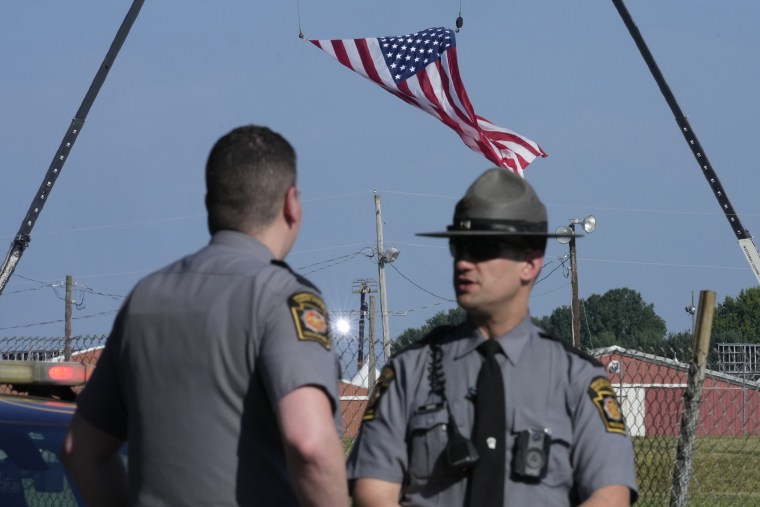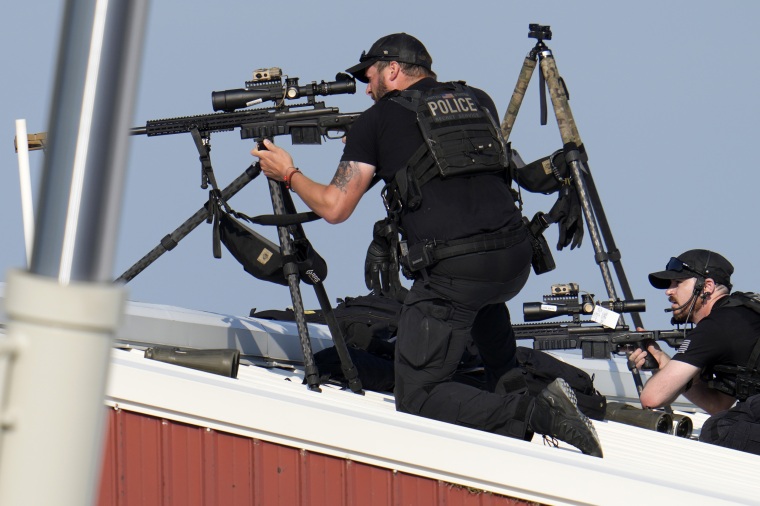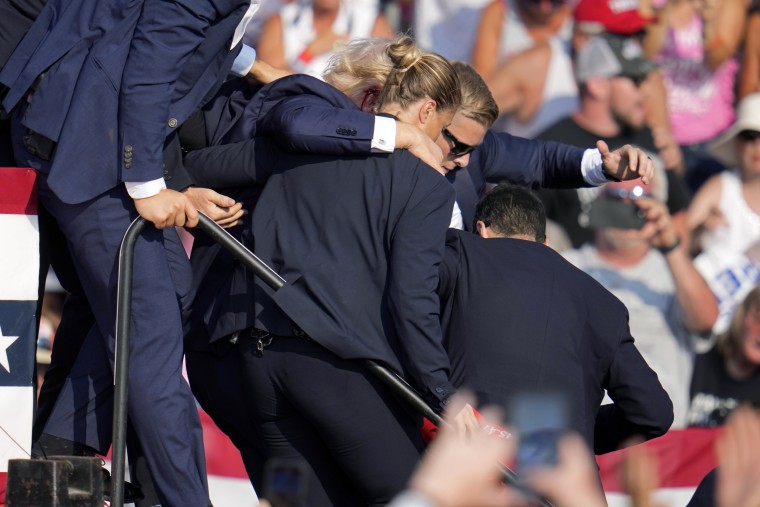The rooftop where a gunman shot at former President Donald Trump during a campaign rally was identified by the Secret Service as a potential vulnerability in the days before the event, two sources familiar with the agency’s operations told NBC News.
The building, owned by a glass research company, is adjacent to the Butler Farm Show, an outdoor venue in Butler, Pennsylvania. The Secret Service was aware of the risks associated with it, the sources said.
“Someone should have been on the roof or securing the building so no one could get on the roof,” said one of the sources, a former senior Secret Service agent who was familiar with the planning.
Understanding how the gunman got onto the roof — despite those concerns — is a central question for investigators scrutinizing how a lone attacker managed to shoot at Trump during Saturday’s campaign event.
The Secret Service worked with local law enforcement to maintain event security, including sniper teams poised on rooftops to identify and eliminate threats, Secret Service spokesman Anthony Guglielmi said. But no officers were posted on the building used by the would-be assassin, outside the event’s security perimeter but only about 148 yards from the stage — within range of a semiautomatic rifle like the one the gunman was carrying.
The Secret Service had designated that rooftop as being under the jurisdiction of local law enforcement, a common practice in securing outdoor rallies, Guglielmi said.Butler County District Attorney Richard Goldinger said his office maintains an Emergency Services Unit team, which deployed four sniper teams and four “quick response teams” at the rally. But he said the Secret Service agents were in charge of security outside the venue.
“They had meetings in the week prior. The Secret Service ran the show. They were the ones who designated who did what,” Goldinger said. “In the command hierarchy, they were top, they were No. 1.”
Goldinger said the commander of the Emergency Services Unit told him it was not responsible for securing areas outside the venue. “To me, the whole thing is under the jurisdiction of the Secret Service. And they will delineate from there,” he said.
The former senior Secret Service agent also said that even if local law enforcement “did drop the ball,” it’s still the agency’s responsibility “to ensure that they are following through either beforehand or in the moment.”
“Just because it is outside of the perimeter, it doesn’t take it out of play for a vulnerability, and you’ve got to mitigate it in some fashion,” the source added.
A volley of shots rang out minutes into Trump’s speech. He reached for his right ear — he said later it was pierced by a bullet — then dropped to the ground as Secret Service agents rushed to shield him. Trump emerged with blood on his ear and his face. One attendee was killed, and two others were injured.Witnesses listening to Trump’s speech from outside the event’s security perimeter recalled pointing out the gunman to law enforcement a couple of minutes before the shooting began. After the gunfire started, Secret Service personnel shot and killed the 20-year-old gunman, Thomas Matthew Crooks.
The clamor over the Secret Service’s biggest failure since the shooting of President Ronald Reagan in 1981 is coming from both political parties, from former agents and from security experts.
“My question is: How did he get onto that roof undetected?” said Anthony Cangelosi, a former Secret Service agent who worked on protective details for presidential candidates, including John Kerry in 2004.
The Secret Service’s work on campaign events like Saturday’s begins with advance planning, setting up a security perimeter and positioning teams on the ground and on rooftops — often in partnership with local law enforcement. The ground deployments include a counterassault team, and the rooftop personnel include counter-sniper teams.

Guglielmi, the Secret Service spokesman, said the agency had two of its counterassault agents at the event and filled out the rest of the platoon with at least six officers from Butler County tactical units. The Secret Service also deployed two counter-sniper teams. Two other security units needed for the event were staffed by local law enforcement agencies, Guglielmi said. Those details were first reported by The Washington Post.Investigators will want to examine the Secret Service’s site security plan for the rally, said Cangelosi, the former Secret Service agent. He expects they’ll discover one of two things: Either officials failed to make an effective plan for keeping potential shooters off the building Crooks fired from, or officers on the ground failed to execute the plan.
“I don’t like making any assumptions, but it does look like some mistakes were made, that this was preventable,” said Cangelosi, now a lecturer at John Jay College of Criminal Justice in New York.
Although it’s common to task local law enforcement agencies with patrolling outside an event’s security perimeter, Cangelosi said, the ultimate responsibility for ensuring that all vulnerabilities are covered rests with the Secret Service.
If officials had placed an officer on the building where the gunman fired from, Cangelosi said, chances are he “wouldn’t even attempt what he attempted.”
“You don’t surrender the discretion of what’s supposed to be done to the local police,” he said. “In other words, you guys have the outer perimeter, but you would want to say, ‘We need an officer on that roof.’ Not ‘that’s your responsibility; do what you see fit.’”
Jim Cavanaugh, a retired special agent in charge with the Bureau of Alcohol, Tobacco, Firearms and Explosives who has worked on Secret Service details, told NBC News that while the Secret Service did a good job taking out the gunman after shots began, the failure to post officers on the building he scaled was “a tremendous lapse.”
“The only way to stop that is you have a lot of people, you get there first, and you command the high ground,” Cavanaugh said. “This is basic, and the Secret Service has done it for years successfully, so I’m really surprised that they did not have that high ground covered.”

The questions extended to Congress, where members demanded answers from the Secret Service and its parent agency, the Department of Homeland Security.“This raises serious concerns regarding how a shooter was able to access a rooftop within range and direct line of sight of where President Trump was speaking,” House Homeland Security Committee Chairman Mark Green, R-Tenn., wrote in a letter to Homeland Security Secretary Alejandro Mayorkas.
Green asked Mayorkas to provide documentation relating to the event’s security plan, the screening of attendees and the level of resources provided to Trump’s Secret Service detail. A committee spokesperson told NBC News that Republican members would hold a briefing with Secret Service Director Kimberly Cheatle on Monday “to voice their concerns and ask pressing questions.”
Another lawmaker, Rep. Ruben Gallego, D-Ariz., wrote Cheatle asking who approved the security plan, whether a proper threat assessment was conducted, whether attendees raised alarms and whether there were failures in following protocols that allowed the attack to happen.
“I call on all those responsible for the planning, approving, and executing of this failed security plan to be held accountable and to testify before Congress immediately,” Gallego wrote in a letter to Cheatle.
Robert McDonald, a former Secret Service agent who ran protection for Joe Biden when he was vice president, told NBC News that he believes the assassination attempt will prompt soul-searching and procedural changes at the agency.
“The Secret Service is going to need to ask some hard questions of itself here and be prepared to stand up and represent why, what happened,” McDonald said.

Cangelosi, the former Secret Service agent, said investigators are also likely to ask when agents identified Crooks as a potential threat, how they reacted and whether it’s possible they could have taken him down before he fired at Trump.Secret Service snipers are trained to make rapid decisions, he said. But it’s possible that if they noticed Crooks on the roof but couldn’t tell whether he had a rifle, agents might have waited to fire on him.
“If the sniper can’t tell whether he has a gun, he or she is not going to take the shot,” Cangelosi said. “Because God forbid it’s a child who’s just excited to see a political candidate, right? So you want to make sure that there’s actually a threat.”
If there was uncertainty, Cangelosi said, it’s possible the sniper team would have dispatched officers to investigate and confirm. But investigating a potential threat can take minutes, he said, while a gunman with a semiautomatic rifle can fire several shots in a matter of seconds.
That’s why, Cangelosi said, the best defense would have been to plan ahead to keep the shooter off the roof in the first place.
“Who wants to be in that position?” he said of the snipers protecting Trump on Saturday. “You’ve got to make a split-second call. And imagine if you’re wrong.”



